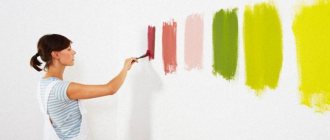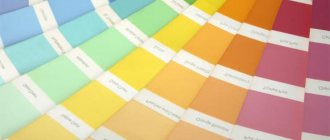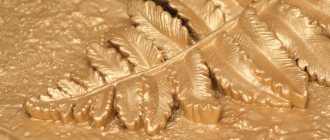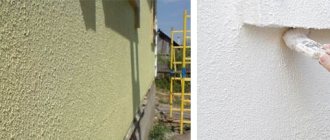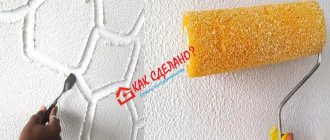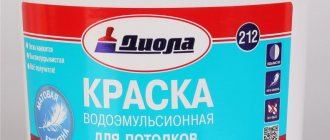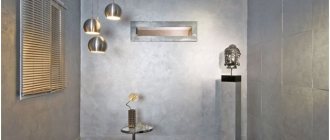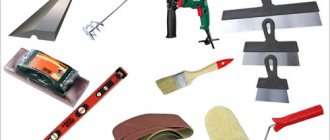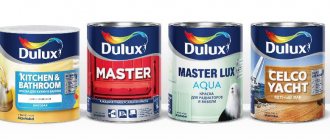The room in which the kitchen is located is rightfully considered one of the most important. This is where food is prepared, guests are received, and the whole family gathers every day. It is essential that the room is functional, safe and aesthetically pleasing. Every housewife is concerned with questions of how and what to paint the walls in the kitchen. The choice of materials for repair work must be approached very carefully. Today, stores are filled with a variety of offers. paint coatings, it is quite difficult to choose the right paint.
Painting a wall with different colors of paint.
What paint to paint the walls in the kitchen
Choosing paint for painting walls.
Deciding which composition is ideal and how to apply it, choosing color and texture - these are the most important questions that every housewife asks when starting a kitchen renovation.
Choosing the texture and color of paint for the kitchen.
All surfaces in the kitchen, such as walls, tiles, furniture and floors, should be easy to clean from dirt, resistant to wet cleaning and temperature changes, resistant to fungus and mold, and at the same time look attractive. A good mood for the whole day is guaranteed if you have breakfast in an ideal kitchen.
Pros and cons of using paint
Before you start choosing a suitable paint and varnish wall covering, you need to identify several advantages and disadvantages of this material. Let's start with the advantages, which include the following features:
At this stage, it is important to note several disadvantages of the material. These include several points:
Having understood the advantages and disadvantages of kitchen paint, everyone has drawn their own conclusions and, if you intend to use this particular material, we recommend that you read the next section.
Advantages of coatings
An excellent choice for the kitchen is washable paint.
Designers have been using paint and varnish materials when decorating for quite some time now, instead of standard wallpaper, tiles or panels.
Why is paint preferable for decorating kitchen walls? The answer to this question is quite simple. The widest palette and the ability to mix tones allows you to choose absolutely any shade. Practicality, low cost, ease of care and application make paint and varnish materials indispensable for designers. Housewives value them for their excellent moisture resistance, wear resistance, resistance to various mechanical influences and the ease of changing the interior.
How to choose a paint color depending on the style of your kitchen interior
Typical of the Scandinavian style are, for example, neutral and cooler tones such as white, cream, gray and navy blue. In comparison, warm colors such as sunny yellow are typical of the country house style.
dancing on the wall of a skyscraper
Delicate pastel shades are the best choice for a vintage kitchen, and for a high-tech style you can choose gold, oil, anthracite, or icy white.
Changing the color of the walls can transform the look of the kitchen
Choice of colors
Choosing paint colors for the kitchen, color palette.
To decide what to paint the walls in the kitchen with, it is important to understand what the room will be used for most often and what mood it should convey.
For example, red color in the interior increases appetite and blood pressure, and also causes discomfort when staying in such a room for a long time. Designers use this color with caution when decorating kitchens.
Kitchen design with red walls.
The orange tint lifts the mood and increases vigor, but in excessive quantities it can irritate the optic nerves.
Kitchen design in warm colors, orange walls.
If you often host family dinners or tea parties, then yellow in the interior is your assistant. It calms and improves the gastrointestinal tract. And dark green , purple and gray colors reduce appetite. Pure white evokes an association with a hospital, and the blue color conceals the space.
It is not at all necessary to paint the walls with just one paint. You can highlight the cooking area or separate the dining group, draw stripes or geometric shapes on the surface.
Separation of kitchen zones using color.
The color scheme should be in harmony with the kitchen set and your mood, that is, it should fit into the kitchen design. After all, the walls in the kitchen can be repainted over time. This is not as important as choosing the color of the walls in the children's room.
Bright kitchens
The most popular solution when choosing wall colors in a small kitchen is light colors. They visually increase the space, which is especially important when there is a fairly large amount of furniture in this room.
Shades of white
White color is an ideal solution for a narrow or small kitchen with low ceilings. The smaller the room, the lighter the shade of white that suits it. Such walls go well with dark furniture and allow it to fit into a small room.
White color is a reason to try to create a stylish black and white combination. Since black furniture and accessories are used as small inclusions on a white base, the interior will not be overloaded.
Another option is to use bright, contrasting colors. This could be patterns on the wall itself or bright furniture that would be difficult to use with another background.
Another stylish combination: light on light. White furniture and light wooden accessories on a light background fill the interior with lightness and freshness.
Source
Types of compositions
Classic kitchen in yellow.
Manufacturers suggest using the following when painting walls:
- Water-based paints , which are a type of water-dispersion composition. They are characterized by the absence of odor, environmental friendliness, the ability to dry quickly and “breathe”. Stains that get on a kitchen wall painted with this composition can be easily removed with a regular rag.
- Alkyd - they smell bad, do not “breathe”, dry very quickly, do not crack and have a high degree of elasticity. They are highly flammable.
- Acrylate is one of the most expensive paint options. It is a mixture of acrylic and latex compounds, characterized by wear resistance and durability. It does not fade in the sun and is not deformed.
- Silicone - relatively recently appeared on the market, are quite expensive and are used for painting plastered textured walls. This is a new generation composition that meets all the requirements for interior paints.
- Latex - do not allow moisture to pass through, dry quickly, forming a protective crystalline film on the surface. They belong to the class of washable interior paints, which are not afraid of chemical detergents.
- Acrylic paints for the kitchen have a wide range of colors, are odorless and dry quickly. When applied, a special film is formed on the surface, which protects the painted wall from abrasion. The color is bright, with a pleasant matte and silky texture.
Painted walls in the kitchen with water-based paint.
Painting the walls in the kitchen with acrylic paint. Some brands offer a variety of decorative compositions that differ in texture, metallic tint or ability to glow in the dark. Some types of dyes imitate the texture of brick or wood. Such paints are environmentally friendly, easy to clean, do not absorb dust and have a high level of wear resistance.
Textured painting of walls in the kitchen using paint.
The assortment of almost any hardware store includes glossy, matte and semi-gloss coatings. Painting kitchen walls with glossy compounds should be done on a perfectly flat surface without rough edges or dents. Any defect will be noticeable. It is worth remembering that a reflective surface visually enlarges the room and hides small spots of dirt. But on a matte finish, on the contrary, any stain will be clearly visible.
Glossy paint for painting walls in the kitchen.
Painting the walls in the kitchen should be done with a composition that is highly moisture-resistant and wear-resistant . The kitchen is a real military training ground for dyes: temperature changes, condensation, grease flying during cooking, and dirt stains. If a painted wall cannot be cleaned of debris and dust, then such a surface will quickly become unusable. The composition must contain elements that prevent the appearance of fungus and mold.
Kitchen design in ethnic style.
The paint should be easy to work with. A parameter such as hiding power is responsible for this. The composition and distinctive characteristics are always indicated on the packaging.
Let's sum it up
As you can see, the list of advantages of kitchen paints is undeniably wider than the list of disadvantages. Moreover, the latter are very conditional and are decided by the right choice. However, it is necessary to understand that each type of paint has its own characteristics, pleasant and not so pleasant. In addition, everyone has their own preferences and something that may seem like a disadvantage to someone may be the main reason for purchasing for another.
You should only buy paints in large stores that value their reputation. In small shops or markets, there is a very high probability of purchasing a fake, which is unlikely to please you with its quality.
Advice! When purchasing, check the tightness of the packaging and pay attention to the structure of the paint itself: the thickness may vary depending on the type and manufacturer, but the mass should be smooth, homogeneous, without foreign elements.
When choosing paint, you should rely not only on your beliefs, but also pay attention to the preferences of your family. After all, the mood of family breakfasts and dinners depends on the color of the kitchen walls.
Choosing washable paint
An example of washable paints for painting walls in the kitchen.
Everyone decides for themselves what paint to paint the walls in the kitchen. Water-based paints are great for this. You can also use any polymer compositions, with the exception of PVA-based dyes. This paint is not resistant to moisture and is only suitable for dry surfaces.
The walls in the kitchen are painted and washable.
Silicone, latex and acrylic kitchen paints are also very popular due to their properties and cost. Don't skimp on the choice of paint. Make the right choice of paint for the walls; the lifespan of the entire room depends on its quality and characteristics.
Choosing a color to suit the room conditions
When choosing new wall paint, the size of your kitchen is critical. For small kitchens, warm and neutral shades are the best choice. Neutral colors such as white, cream, terracotta, beige, chocolate brown and even gray make every small room feel more spacious.
And warm colors - sunny yellow, orange, red create a cozy and welcoming atmosphere. It’s better not to overdo it - as they say, “less is more.” Instead of painting your entire kitchen bright red, it would be much better to just add an accent wall or pay more attention to the details.
Various nuances in the kitchen look very stylish, but they need to be used with caution so that they do not create an overloaded atmosphere
How to prepare walls for painting
Preparing walls, leveling, in the kitchen for painting.
Painting kitchen walls must be done on a perfectly smooth and even surface. First, you need to remove all stains, traces of dirt and grease, soot, old wallpaper, tiles and other materials. Any crumbling plaster must also be removed.
Fungus and mold, if present, are removed mechanically. The surface in this place is treated with special antibacterial compounds. Potholes are covered with cement or gypsum-based plaster.
Applying paint to decorative putty for kitchen decoration.
The walls are leveled using plaster or moisture-resistant acrylic putty, applied in two or three layers. To increase adhesive properties, primer is applied after each layer.
A deep penetration primer is preferable. It is not expensive and can be diluted with water 1:1
It is recommended to choose moisture-resistant putty from the same company as the paint, because their compatibility will determine how long the paint will dry, the appearance and strength of the coating, resistance to various damages and resistance to wet cleaning.
Creating a design in the kitchen with your own hands, painting the walls.
To obtain an ideal surface, the dried final layer must be sanded.
Surface preparation before painting
Preparatory work includes the following steps:
- first of all, any contaminants are removed, for example, dust, dirt, old paints and varnishes, traces of mold, crumbling areas of finishing, etc.;
- if the walls are loose, crumbling, and also if they have defects (cracks, chips, potholes, etc.), putty must be performed;
- walls or ceilings are carefully processed using fine-grained sandpaper;
- one or two coats of primer are applied. Thanks to priming, the rate of adhesion (adhesion) of the paint to the surface increases significantly, and the wall also acquires additional protection;
- After applying the primer, experts recommend sanding the walls again. After cleaning and sanding, be sure to remove dust from the surface with a damp cloth.
Only when the wall area is smooth, clean and dry can you begin painting.
How to paint the walls in the kitchen
Modern design in the kitchen.
The first step is to prepare everything that may be required in the process:
- Work clothes that you won’t mind throwing away and protective equipment (goggles, respirator)
- Solvents and wipes for cleaning hands and tissues
- Specialized tools: brushes, rollers, masking tape, paint container
- Kitchen wall paint
To begin with, it is recommended to use a medium-sized brush to go through all the corners, hard-to-reach places and the perimeter of the baseboards, then apply the composition to the entire surface with a wide brush or roller.
Work is carried out from top to bottom from the ceiling. Using masking tape, seal the ceiling in the places where it connects to the wall. This allows you to prevent the paint composition from getting onto undesirable surfaces and create an even color.
The quality of the coloring also directly depends on the quality of the roller. Experts recommend using a mohair roller to paint the kitchen area.
Painting kitchen walls with a mohair roller.
It is best to do strokes simultaneously in different directions: from right to left and from top to bottom. Shading will help distribute the paint on the surface as evenly as possible, preventing the appearance of streaks and streaks.
Water-based paints are applied using a W-shaped motion. Then soft vertical and horizontal strokes alternate from the ceiling to the floor. If you plan to apply the substance in two layers, then the sequence should be the first layer vertical, the second horizontal. If in three, then vertical-horizontal-vertical. At the same time, water-dispersed compositions do not require complete drying to apply subsequent layers.
Painting walls with a roller yourself is a very labor-intensive process. The composition must be evenly distributed over the entire surface, carefully rolling it out. Air bubbles and debris falling onto the painted layer must be removed mechanically.
Latex
This is a familiar water-based kitchen paint with the addition of latex compounds. Its cost is higher than acrylic, but it is superior in wear resistance.
The main advantage of using a latex paint mixture in the kitchen is the ability to wash with mild abrasives and non-metallic bristles. They can be used to clean heavily soiled areas, such as above the stove or sink. The latex base can withstand cleaning with disinfectants, which will not affect its appearance in any way.
Easy care allows you to choose the lightest shades
Other benefits include:
- High wear resistance. It is considered one of the most resistant among the washable series. Some types can withstand intense cleaning;
- No smell. The mild residual aroma disappears within a few seconds;
- Fast drying. Complete drying in about 20 minutes, but if there is high humidity in the kitchen, the time can increase to 2 hours;
- Possibility of painting any surface - concrete, foam plastic, wallpaper and even tiles;
- It allows air to pass through, preventing bubbles and unevenness from appearing.
Flaws:
- High price;
- Possibility of mold growth. To avoid this, before painting the surface is treated with an antiseptic primer.
Safety
Minimal protection when painting walls.
When carrying out paint and varnish work with your own hands, you need to follow the simplest rules:
- Be sure to wear safety glasses and rubber gloves to prevent dye from getting on your skin and mucous membranes. Hair is hidden under a headdress.
- Use only serviceable, stable ladders and stands.
- The air in the room should flow freely at all times. But you should not allow drafts to form.
Painting the walls in the kitchen with your own hands is a complex but very interesting process. The final result directly depends on the efforts you put in and the patience you show.
Benefits of Benjamin Moore Paints
Benjamin Moore paints are premium coatings that are popular with consumers today because they have the following advantages:
- Huge palette of shades.
- High safety and environmental friendliness.
- Premium paints are distinguished by excellent quality characteristics and properties.
- Suitable for use both indoors and outdoors.
- Can be used for swimming pools, concrete, wood, metal and so on.
Benjamin Moore is the best paint today, as the highest requirements for environmental friendliness and safety are met during production. Also, lead and mercury are not used in the production of paints, and the use of solvents is reduced to a minimum. In addition to the highest quality, consumers also note the incredible durability of such coatings, which do not change their appearance even after several years.
Gallery: Kitchen wall painting design
There are no similar articles.
